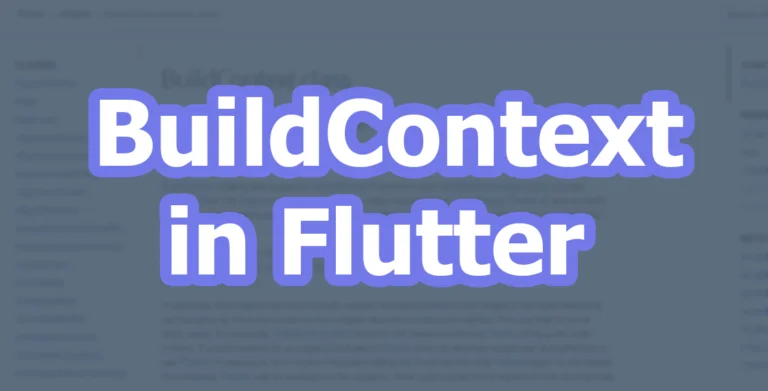BuildContext is a handle to the location of a widget in the widget tree.
Flutter is a mobile app development framework created by Google. It allows developers to create beautiful and smooth-running apps for Android and iOS devices using a single codebase. One of the key concepts in Flutter is the idea of a “widget.” Widgets are small pieces of code that define how an app looks and behaves. They can be simple, like a button or a text field, or they can be more complex, like a list or a tab bar.
In Flutter, BuildContext is a special object that is passed to the “build” method of a widget. The build method is a function that is called every time a widget needs to be drawn on the screen. The BuildContext object contains information about the location of the widget in the app’s hierarchy, as well as other useful data.
Alright, fellow Flutter enthusiasts, gather ’round! Let’s dive into the wild and sometimes confusing world of BuildContext. Now, I know what you’re thinking – “Oh great, another technical Flutter concept that’ll make my brain hurt.” But stick with me here, because understanding BuildContext is like unlocking a secret superpower in your Flutter development journey.
I remember when I first encountered BuildContext. I was knee-deep in my first Flutter project, feeling pretty good about myself. Widgets? Check. State management? Getting there. Then BAM! BuildContext entered the chat, and suddenly I felt like I was trying to solve a Rubik’s cube blindfolded.
But here’s the thing – once you get your head around BuildContext, it’s like putting on a pair of x-ray goggles for your Flutter app. Suddenly, you can see how everything connects, how to access the stuff you need, and how to make your app do some pretty cool tricks.
So, grab your favorite caffeinated beverage, get comfy, and let’s unravel the mystery of BuildContext together. Trust me, your future self (and your Flutter apps) will thank you for this!
Understanding Widgets in Flutter
In Flutter, everything is a widget. This includes components like forms, menus, buttons, text, padding, and margins. All the widgets in a Flutter app are organized in a Widget Tree, where parent and child widgets are connected. This hierarchical structure allows for a clear and manageable organization of the user interface.
The Role of BuildContext
The BuildContext helps locate a specific widget in the tree and understand its relationship with other widgets. Each widget has its own BuildContext, created by the build method and passed as an argument. The BuildContext of a parent widget is the parent of the BuildContext of its children. We use BuildContext to access the app’s theme and localizations, modify the parent widget or show dialogs/snackbars, and build responsive widgets for different screens and devices.
State vs BuildContext
The relationship between state and BuildContext is that the state of a widget is often stored in its ancestor widgets. When the state of an ancestor widget changes, the BuildContext of its descendant widgets also changes, which triggers a rebuild of the widget tree.
We need BuildContext to change the look and feel of an app because it allows us to access and modify the widget tree and its ancestor widgets. This enables us to update the appearance and behavior of the app in response to user input or other events.
The BuildContext of a parent widget is the parent of the BuildContext of its direct children widgets. This means that a child widget can locate its parent widget by using the BuildContext. For example, the following code can be used to locate the Scaffold widget from the FlatButton widget in the widget tree structure: Scaffold > Center > Row > FlatButton:
context.ancestorWidgetOfExactType(Scaffold)In addition to locating parent and child widgets, BuildContext can also be used to pass messages from a parent widget to a child widget in the widget tree. This can be achieved using InheritedWidgets.
Every Flutter widget has an @override build() method with the argument of BuildContext.
class CartItemWidget extends StatelessWidget {
@override
Widget build(BuildContext context) {.....
Simple explanation is that the BuildContextin Flutter is:
- A BuildContext only belongs to one widget.
- BuildContext objects are passed to WidgetBuilder functions

A BuildContext only belongs to one widget.
A BuildContext is specific to one widget and is only accessible to that widget or its parent’s BuildContext. It is used in WidgetBuilder functions, like StatelessWidget.build and can be accessed with State.context. Some static functions, such as showDialog and Theme.of, also require a BuildContext as an argument to perform actions for the calling widget or to get data for a specific context.
Each widget has its own BuildContext, which becomes the parent of the widget returned by StatelessWidget.build or State.build. The build context of a widget’s build method is not the same as the build context of the returned widget. This can cause problems, for example, if a build method for a widget Q includes a Theme in its returned widget tree and tries to use Theme.of with its own context, it will not find the Theme object. Instead, it will find the nearest ancestor Theme to widget Q. To access the build context of a returned widget tree, use a Builder widget. The build context passed to Builder.builder will be the Builder’s own context.
Now that we’ve got the basics down, let’s roll up our sleeves and get our hands dirty with some real-world BuildContext scenarios. Because let’s face it, theory is great, but nothing beats seeing BuildContext in action!
Scenario 1: The Theme Thief Picture this: you’re building a sleek, dark-themed app. Everything’s looking great, but suddenly you need to access the theme data in a deeply nested widget. What do you do? BuildContext to the rescue! Here’s a quick snippet:
Widget build(BuildContext context) {
final theme = Theme.of(context);
return Text(
'Look ma, I'm using the theme!',
style: theme.textTheme.headline6,
);
}See what we did there? We used BuildContext to snag the current theme, no matter how deep in the widget tree we are. It’s like having a secret passage to the app’s style guide!
Scenario 2: The Responsive Ranger Let’s say you’re building an app that needs to look good on both phones and tablets. BuildContext can help you become a responsive layout ninja:
Widget build(BuildContext context) {
final screenSize = MediaQuery.of(context).size;
return screenSize.width > 600
? WideLayout()
: NarrowLayout();
}With BuildContext, you can access device information and adapt your layout on the fly. It’s like having a shape-shifting app!
Scenario 3: The Navigator’s Compass Ever needed to navigate to a new screen but found yourself lost in a sea of widgets? BuildContext is your trusty compass:
onPressed: () {
Navigator.of(context).push(MaterialPageRoute(
builder: (context) => DetailsScreen(),
));
}No matter where you are in the widget tree, BuildContext helps you find your way to the Navigator. It’s like having a teleporter in your pocket!
Remember, these are just a few examples of the BuildContext magic. As you keep Flutter-ing (is that a word? It is now!), you’ll discover even more ways this little context can make your life easier. Just remember – with great power comes great responsibility. Use your BuildContext wisely, and may your widgets always build true!
Widget, buildContext and Theme Data
In Flutter, the BuildContext is a handle to the location of a widget within the widget tree. It is passed to the build method of a widget when it is inserted into the tree, and can be used to access the widget’s parent, ancestors, and children.
The BuildContext is also used to access the widget’s Theme data, which is used to style the widget. The BuildContext allows a widget to access the theme data that is most relevant to it, even if that theme data is defined higher up in the widget tree.
Additionally, the BuildContext can be used to access the widget’s State object, which is used to manage the internal state of the widget. This is useful for widgets that need to update their appearance or behavior based on changes to their state.
Things to Look out for:
BuildContext can cause issues. For example, if a build method tries to access a Theme using its own context, it will find the ancestor Theme object instead. Use a Builder widget with the build context passed to the builder callback to access the BuildContext for a part of the returned tree.
Referencing a widget that is not part of the current build tree can occur when using BuildContext, causing errors and unpredictable behavior.
It can be tough to understand the context in which a widget is being built when using BuildContext, making it hard to debug problems and make changes to the widget tree.
In Flutter, everything is a widget, including buttons, text, padding, and margins. These widgets are organized in a widget tree, where each widget has a parent-child relationship with the others. The BuildContext of a widget is a handle to its location in the widget tree. It is passed as an argument to the build method, which creates and draws the widget.
Whew! We’ve been on quite the BuildContext journey, haven’t we? From demystifying its role in the widget tree to seeing it in action with real-world scenarios. But you know what? This is just the beginning of your BuildContext adventure.
As you continue your Flutter development journey, you’ll find yourself reaching for BuildContext in all sorts of situations. It’s like a Swiss Army knife for your Flutter apps – always there when you need it, with just the right tool for the job.
So, what’s next on your BuildContext bucket list? Here’s a little challenge for you: try to use BuildContext in a way we haven’t covered in this post. Maybe you’ll use it to access a custom InheritedWidget, or perhaps you’ll find a clever way to use it for app-wide state management. Whatever you do, I want to hear about it!
Drop your BuildContext experiments in the comments below. Did you have any “aha!” moments? Any head-scratching conundrums? Any cool tricks you discovered? Let’s learn from each other and build an awesome Flutter community!
Remember, every Flutter master was once a BuildContext beginner. So don’t get discouraged if it feels tricky at first. Keep coding, keep experimenting, and before you know it, you’ll be wielding BuildContext like a pro.
Happy Flutter-ing, and may your contexts always build bright!
To Learn more about the topic, please refer to the original flutter docs – BuildContext in Flutter

